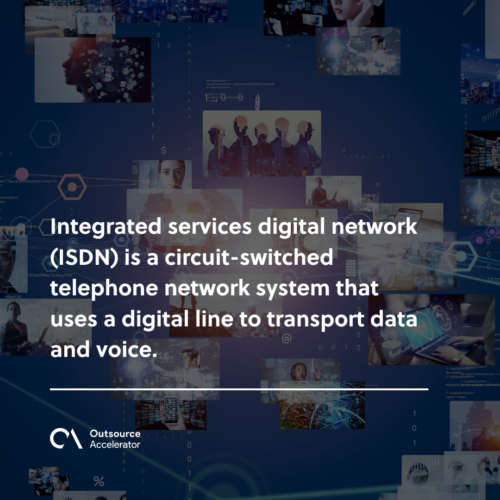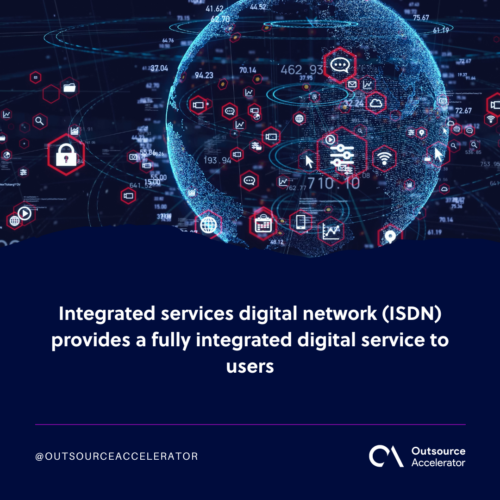Integrated Service Digital Network (ISDN)
Definition
What is an Integrated Service Digital Network (ISDN)?
Integrated services digital network (ISDN) is a circuit-switched telephone network system that uses a digital line to transport data and voice.
It is a series of communication protocols that involve digital transmission to make phone conversations, and video calls, and transfer data over existing public switched telephone network connections (PSTN).
In addition, it has a distinction for providing effective and reliable connections rather than traditional ones. Data transfers can flow more reliably with faster speeds and better connections.
A SIP trunk provider, which uses the data for business phone service to a PBX, is the modern update to an integrated services digital network (ISDN).

What are the advantages of an integrated services digital network (ISDN)?
Integrated services digital network (ISDN) started as an alternative to dial-up connections that gave faster internet speed connections. Through ISDN, customers are required to access a digital modem to connect to the internet.
In regions where broadband internet is unavailable, people continue to use ISDN for internet access. It also provides various digital services that function over the same copper cable and digital signals for transmission through telephone lines.
Further, ISDN has a greater data transmission rate and can connect devices and allow them to function over a single line. Credit card readers, fax machines, and various gadgets fall under this category.
How does an integrated services digital network (ISDN) work?
The traditional copper telephone connection is divided into various digital channels through ISDN. These channels work simultaneously on a single copper line, allowing various phones to make and receive calls on the same physical line at the same time.
What are the types of integrated services digital networks (ISDN)?
Basic rate interface and primary rate interface are the two main types of integrated services digital network (ISDN).
Basic rate interface (BRI)
A basic rate interface (BRI) is an ISDN configuration that is typically used for voice-grade telephone services. It is widely found in various countries and is installed in households and small and medium enterprises.
Primary rate interface (PRI)
The primary rate interface (PRI) transports various digital signal zero (DS0) services and data between the ISDN network and a user. PRI is frequently used by leading companies, offices, and businesses in the world.
What are the services of an integrated services digital network (ISDN)?
Integrated services digital network (ISDN) provides a fully integrated digital service to users as it falls under three main categories, which are bearer services, teleservices, and supplementary services.
Bearer services
The bearer services provide information through the network without affecting the content of that information. The content remains constant, as it does not need the network to process the information.
It is part of the first three levels of the open systems interconnection (OSI) model and they are specified in the ISDN standard. They can also be delivered through circuit-switched, packet-switched, frame-switched, or cell-switched networks.
Teleservices
Teleservices focus on the capacities of bearer services and are designed to meet the demands of complicated users. These services can alter or process the data’s contents.
The user does not need to be aware of the process’s specifics. Telephony, telefax, videotex, and teleconferencing are examples of teleservices.
Further, ISDN specifies these services by name, but they have not yet become standards.
Supplementary services
Supplementary services give additional functionality to bearer services and teleservices. Reverse billing, call waiting, and message handling is examples of supplementary services that are commonly used in today’s telecommunications company services.

What are the main variations of an integrated services digital network (ISDN)?
There are three variations of an integrated services digital network (ISDN) such as basic rate interface, primary rate interface, and broadband ISDN, as listed by techopedia.
Basic rate interface (BRI-ISDN)
The basic rate interface (BRI), also known as ISDN2 was originally used as the standard internet connection option and is capable of transferring data at a speed up to 128 Kbps.
It was designed primarily for small business and household usage, however, ISDN operates over pre-existing copper telephone lines, the claimed 128 Kbps speed is rarely achieved.
Primary rate interface (PRI-ISDN)
The primary rate interface (PRI) was a high-speed ISDN that was primarily designed for business purposes since it supported full T1 rates of 1.544 Mbps and up to 2.048 Mbps on E1 (E-carrier system).
PRI uses 23 parallel 64 Kbps carrier channels instead of the two channels used for BRI. E1 lines, which can accommodate up to 30 bearer channels, are commonly used in Europe and Asia.
To distinguish them from ISDN2, they were sometimes referred to as ISDN30.
Broadband ISDN (B-ISDN)
Broadband ISDN (B-ISDN) is the advanced form of ISDN that could carry hundreds of Mbps of data in download and upload through fiber-optic lines using ATM switching technology.
It surpassed ADSL technologies, however, became outdated before it could be a widespread technology. B-ISDN is currently used as an entry-level layer in DSL and WiMAX systems.







 Independent
Independent




